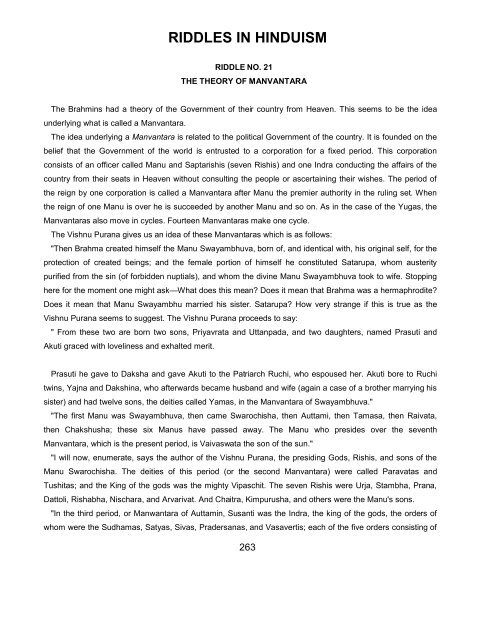Create successful ePaper yourself
Turn your PDF publications into a flip-book with our unique Google optimized e-Paper software.
RIDDLES IN HINDUISM<br />
RIDDLE NO. 21<br />
THE THEORY OF MANVANTARA<br />
The Brahm<strong>in</strong>s had a theory of the Government of their country from Heaven. This seems to be the idea<br />
underly<strong>in</strong>g what is called a Manvantara.<br />
The idea underly<strong>in</strong>g a Manvantara is related to the political Government of the country. It is founded on the<br />
belief that the Government of the world is entrusted to a corporation for a fixed period. This corporation<br />
consists of an officer called Manu and Saptarishis (seven Rishis) and one Indra conduct<strong>in</strong>g the affairs of the<br />
country from their seats <strong>in</strong> Heaven without consult<strong>in</strong>g the people or ascerta<strong>in</strong><strong>in</strong>g their wishes. The period of<br />
the reign by one corporation is called a Manvantara after Manu the premier authority <strong>in</strong> the rul<strong>in</strong>g set. When<br />
the reign of one Manu is over he is succeeded by another Manu and so on. As <strong>in</strong> the case of the Yugas, the<br />
Manvantaras also move <strong>in</strong> cycles. Fourteen Manvantaras make one cycle.<br />
The Vishnu Purana gives us an idea of these Manvantaras which is as follows:<br />
"Then Brahma created himself the Manu Swayambhuva, born of, and identical with, his orig<strong>in</strong>al self, for the<br />
protection of created be<strong>in</strong>gs; and the female portion of himself he constituted Satarupa, whom austerity<br />
purified from the s<strong>in</strong> (of forbidden nuptials), and whom the div<strong>in</strong>e Manu Swayambhuva took to wife. Stopp<strong>in</strong>g<br />
here for the moment one might ask—What does this mean? Does it mean that Brahma was a hermaphrodite?<br />
Does it mean that Manu Swayambhu married his sister. Satarupa? How very strange if this is true as the<br />
Vishnu Purana seems to suggest. The Vishnu Purana proceeds to say:<br />
" From these two are born two sons, Priyavrata and Uttanpada, and two daughters, named Prasuti and<br />
Akuti graced with lovel<strong>in</strong>ess and exhalted merit.<br />
Prasuti he gave to Daksha and gave Akuti to the Patriarch Ruchi, who espoused her. Akuti bore to Ruchi<br />
tw<strong>in</strong>s, Yajna and Daksh<strong>in</strong>a, who afterwards became husband and wife (aga<strong>in</strong> a case of a brother marry<strong>in</strong>g his<br />
sister) and had twelve sons, the deities called Yamas, <strong>in</strong> the Manvantara of Swayambhuva."<br />
"The first Manu was Swayambhuva, then came Swarochisha, then Auttami, then Tamasa, then Raivata,<br />
then Chakshusha; these six Manus have passed away. The Manu who presides over the seventh<br />
Manvantara, which is the present period, is Vaivaswata the son of the sun."<br />
"I will now, enumerate, says the author of the Vishnu Purana, the presid<strong>in</strong>g Gods, Rishis, and sons of the<br />
Manu Swarochisha. The deities of this period (or the second Manvantara) were called Paravatas and<br />
Tushitas; and the K<strong>in</strong>g of the gods was the mighty Vipaschit. The seven Rishis were Urja, Stambha, Prana,<br />
Dattoli, Rishabha, Nischara, and Arvarivat. And Chaitra, Kimpurusha, and others were the Manu's sons.<br />
"In the third period, or Manwantara of Auttam<strong>in</strong>, Susanti was the Indra, the k<strong>in</strong>g of the gods, the orders of<br />
whom were the Sudhamas, Satyas, Sivas, Pradersanas, and Vasavertis; each of the five orders consist<strong>in</strong>g of<br />
263


















